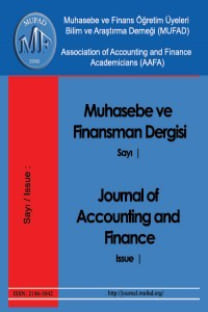İşletme Grupları Ve Sermaye Yapısı İlişkisi
İşletme grupları, sermaye yapısı, sahiplik yapısı, panel data, içsel sermaye piyasaları
___
- Anderson, R.C. - Mansi, S.A. - Reeb, D.M. (2003), “Founding family ownership and the agency cost of debt”, Journal of Financial Economics, Vol.68, issue.2, pp: 263-285
- Arellano, M. - Bond, S.,(1991), “Some tests of specifications for panel data: Monte Carlo evidence and an application to employment equations”, Review of Economic Studies, Vol.58, pp:277-297.
- Boyle, G.W. - Eckhold, K.R (1997), “Capital structure choice and financial market liberalization: evidence from New Zealand”, Applied Financial Economics, Volume 7,Issue 4, pp:427-437
- Faccio, M, - Lang, L.(2002), “The ultimate ownership of western European corporations”, Journal of Financial Economics,Vol.65, pp: 365-395.
- Fama, E. - Jensen, M.C.(1983), “Separation of ownership and control”, .Journal of Law and Economics, Vol.26,pp: 301-325.
- Feenstra, R.C. - Huang, D.S ve Hamilton, G.G. (2003), “A market power based model of business groups”, Journal of Economic Behavior and Organization, Vol. 51,pp: 459-485
- Galai, D. - Masulis, R.(1976), “The option pricing model and the risk factor of stock”, Journal of Financial Economics, Vol. 3, issue 1-2,pp: 53-81
- Gertner, R.H.,Scharfstein, ve D.S, Stein, C.S. (1994), “Internal versus external capital markets”, NBER Working Paper Series, Working Paper No.4776
- Gonenc, H.- Kan, O. - Karadagli, H. (2007), “Business groups and internal capital markets”, Emerging Markets Finance and Trade, Vol.43, No.2, pp: 63-81
- Gonenc, H.- Kan, O. - Karadagli (2004), “Corporate diversification and internal capital markets: Evidence from the Turkish Business Groups”, Basel Meetings paper, EFMA 2004, https://papers.ssrn.com/sol3/papers.cfm?abstract_id=500163
- Gronovetter, M. (1995), “Coase revisited: Business groups in the modern Economy”, Industrial and Corporate Change, Vol.4, Issue.1, pp:93-130, https://doi.org/10.1093/icc/4.1.93
- Guillén M.F. (2000), “Business groups in emerging economies: a resource based view”, Academy of Management Journal, Vol.43, pp: 362-380
- Hsiao, C.(1985), “Benefits and limitations of panel data”, Economic Review, Vol.46, issue.4, pp:1251–1271
- Hoshi, T. - Kashyap, A. - Scharfstein, D. (1990), “The role of banks in reducing the costs of financial distress in Japan”,Journal of Financial Economics, Vol.27, issue.1,pp: 67-88
- Jensen, M. - Meckling, W. (1976), “Theory of the firm: managerial behaviour, agency costs and capital structure”, Journal of Financial Economics, Vol.3,pp: 305-360
- Jensen M. (1986), “Agency costs of free cash flow, corporate finance, and takeovers”, American Economic Review, Vol. 76, No. 2,pp. 323-329
- Khanna T. - Palepu K. (2000), “The future of business groups in emerging markets: Long – run evidence from Chile”, Academy of Management Journal, Vol., pp: 268-285.
- Khanna T, Rivkin J W. (2001), “Estimating the performance effects of business groups in emerging markets”, Strategic Management Journal, Vol.22, pp: 45-74,
- Khanna, T. - Rivkin,J W. (2006), “Interorganizational ties and business groups boundaries: Evidence from an emerging economy”, Organization Science, Vol.17, Issue.3, pp:333-352
- Khanna T.(2000), “Business groups and social welfare in emerging markets: existing evidence and unanswered questions”, European Economic Review, Vol.44,pp: 748-761.
- Kraus, A. - Litzenberger, R. (1973), “A state-preference model of optimal financial leverage”, The Journal of Finance,Vol.28,No.4,pp.911-922
- Leff, N. (1978), “Industrial organization and entrepreneurship in the developing countries: The economic groups”, Economic Development and Cultural Change ,Vol.26, pp: 661-675
- Manos, R.- Murinde, V. - Green, C.J. (2007), “Leverage and business groups: evidence from Indian firms”, Journal of Economics and Business, Vol.59, pp: 443-465
- Myers, S.C. (1984), “The capital structure puzzle”, Journal of Finance, Vol.39, issue.3, pp:575-592
- Myers,S. - Majlup, F.(1984), “Corporate financing and investment decisions when firms have information that investors do not have”, Journal of Financial Economics, Vol. 13, pp:187-221
- Myers, S. (1977), “Determinants of corporate borrowing”, Journal of Financial Economics, Volume 5, Issue 2, pp: 147-175
- Prasad, S.- Green, C.J - Murinde, V. (2001), “Company financing, capital structure and ownership: A survey and implications for developing economies”, Loughborough University Economics Research Paper, http://dspace.lboro.ac.uk
- Rajan, R. - Zingales, L. (1995), “What do we know about capital structure? Some evidence from international data”, Journal of Finance, Vol. 50,pp: 1421-1460.
- Shleifer, A. - Vishny, R.W. (1986), “Large shareholders and corporate control”, Journal of Political Economy, Vol.94, issue.3, pp:461-488.
- Tatoğlu, Y.F. (2013), “İleri panel veri analizi”, Beta Yayınları, İstanbul
- Titman S. - Wessels R. (1988), “The determinants of capital structure choice”, Journal of Finance, Vol. 43, No. 1,pp. 1-19.
- ISSN: 2146-3042
- Yayın Aralığı: 4
- Başlangıç: 2005
- Yayıncı: Muhasebe ve Finansman Öğretim Üyeleri Derneği (MUFAD)
Türkiye’deki Emeklilik Şirketlerinin Etkinlik Analizi
Neilan SOYLU, Hasan UYGURTÜRK, Turhan KORKMAZ
Aylin POROY ARSOY, Yasemin ERTAN, Tuba BORA KILINÇARSLAN
Tahakkuk Kalitesi ve Kârın Süreğenliği Arasındaki İlişkinin İncelenmesi: BIST 100 Örneği
Denetçi Seçimine Etki Eden Faktörlerin Analizi: Borsa İstanbul’dan Bulgular
En Yüksek Piyasa Değerine Sahip On Kripto Paranın Birbirleriyle Etkileşimi
Gökben ADANA KARAAĞAÇ, Serpil ALTINIRMAK
Yatırım Amaçlı Gayrimenkullerin Örnek Vakalarla İncelenmesi
Yeni Muhasebe Uzmanlık Alanlarının Muhasebe Eğitimindeki Yeri Ve Türkiye Örneği
